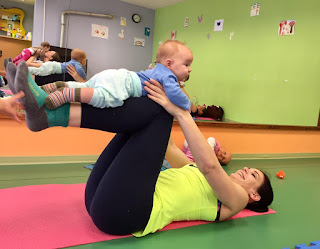Rectus Diastasis – the separation of abdominal muscles
The tummy is the part of our body that gets most often labelled as "problematic". Men want to get rid of their beer belly while women are working on their postnatal tummy. Unfortunately, most of the times incorrectly - so the result becomes even worst.
 |
| https://commons.wikimedia.org/wiki/File:Grays_Anatomy_image392.png |
The (most important) abdominal muscles from the outside inwards are: rectus abdominis, external obliques, internal obliques and transversus abdominis. (We do not explain now the quadratus lumborum and the PIRAMIDAL muscles even though the quadratus lumborumpays an important role in bending the trunk to the sides.)
The connective tissue dividing the abdominal muscles in the midline of the body is called Linea Alba. If this connective tissue is stretched out, then the rectus abdominis muscles get far from each other and cannot perform their function.
What are the functions of the abdominal muscles?
- Close the abdominal cavity and protect the organs of the abdominal cavity.
- Stabilize the organs of the abdominal
- They take part in several movements of the body due to their various directions.
- They also contribute to maintain the intraabdominal pressure.
- Their functions pay an important role in the exhalation
- Urination, defecation
- Sneezing and coughing
- Labour
- Lifting heavy objects
- Stabilization of the pelvic floor muscles
- Turning the trunk in all directions.
The list is not complete yet.
If your abdominals don't properly fulfil their role then more weight is going to the pelvic floor muscles, to the spine, the muscular balance is overwhelmed, and the results are going to be pain, bad posture, weak pelvic floor muscle and bigger tummy.
The minimum 2 cm (0,79 inch) separation of the rectus abdominis in the midline is called Rectus Diastasis.
The overstretched connective tissue is not anymore able to recover itself thus it's not able to keep the right and left parts of the rectus abdominis so close together to fulfil their functions. The overstretched tissue is also thinner, and a thin connective tissue is weak. If this problem persists then the muscles should be held in place with muscle strength so with conscious, careful and continuous awareness and exercising the state can be kept at the same level and the symptoms can be treated.
It is common that people do crunches and sit-ups as starting exercises. However, without a properly strengthened transversal abdominal muscle these exercises aren't done correctly so the rectus diastasis can develop even if it didn't exist before. Specially for women in the post-natal period who are under hormonal conditions and thus have loose connective tissues. It can develop for tubby men or for anyone as consequence of any illnesses with bloated belly.
Look at this man, he has nice 6 packs. But in the midline, you can see how far his rectus abdominis are from each other. What we can't see on the picture is the lower back pain he may goes through, that he might even takes pills for it and probably has no clue whatisthis. We can’t see what kind of difficulties does he (or is he going to) have due to weak pelvic floor muscles. We do not know how often was he operated for umbilical hernia.
Pic: de.wikipedia.org
So boys and girls, women and men –we need to treat our tummy carefully and mindfully. You can have a flat belly or even a six pack but only with proper training!
Continue reading our blog, you can find a lot of useful articles and exercises in this subject.
Follow our Facebook page and Instagram profile to keep up to date when you need motivation or tips.
Fitness trainer
Pre- and Postnatal Fitness Specialist
Country Leader of Kangatraining in Hungary
RTM - Rectus Training Method Founder






Comments
Post a Comment